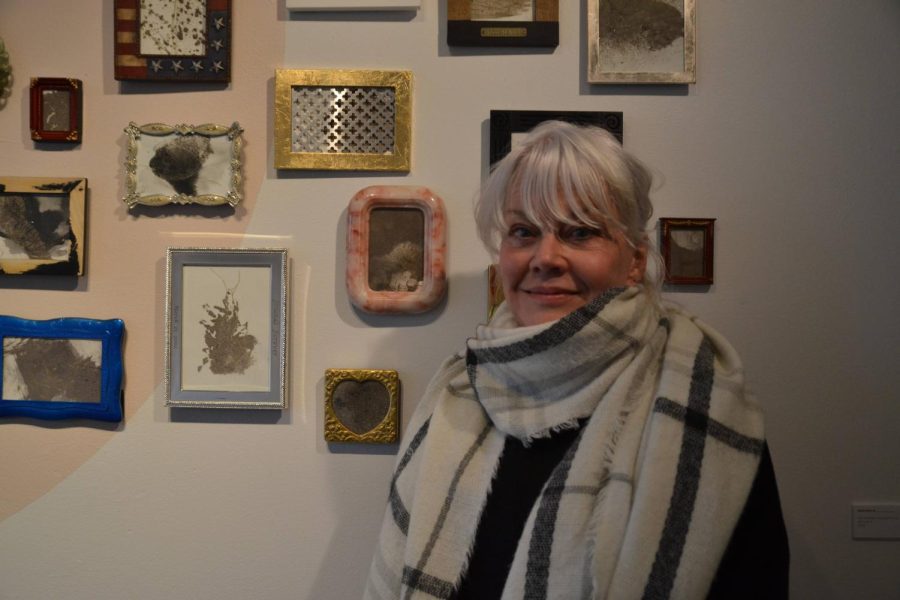Connie Noyes’ ‘we are built in water’ exhibit explores personal and collective grief
The artist stands in front of framed ash paintings threaded with gold. “we are built in water” explores grief and the cycles of life and death.
November 21, 2022
When Connie Noyes lost her husband and father within 10 days of each other, art served as a crucial healing and coping mechanism. Noyes’ most recent exhibit, “we are built in water,” reflects on grief and the cycle of life and death. It is on display at the Evanston Art Center through Dec. 18.
Themes of water thread through the abstract exhibit, which employs many mediums, including sculpture, video and ash painting. Noyes said alongside her personal grieving process, the show also explores collective grief caused by the COVID-19 pandemic. Water is the metaphor for both birth and death, according to Noyes.
“The metaphor for birth is more obvious — we’re in this incubation in the mother’s water for nine months,” Noyes said. “When we come out and scream, it is, I believe, the first cry of grief. I see the ocean as a repository of tears from all the grief that has been shared over millennia.”
Audrey Avril, the manager of exhibitions at the Evanston Art Center, said Noyes’ multiple artistic mediums add to the visitor’s experience of emotions. She said there is a kaleidoscope of different sensory introductions, like the waves crashing in a video playing on-screen in the exhibit and the visible patchwork of the suspended chair sculptures that enable visitors to experience grief at their own pace.
Avril said the exhibit depicts both small and large moments of loss, allowing the art to resonate on different levels.
Peter Fleps, the director of developmental art venue Wedge Projects in Chicago, said he thinks Noyes’ show attempts to acknowledge healthy ways of grieving and continuing to live. He described Noyes as an explorer and battler in her artistry.
“The emphasis is not just on grief and death — it’s on life,” Fleps said. “A life that isn’t killed by grief but is not ignorant of grief.”
Grief is universal and has been intensified by the pandemic, according to Tricia Van Eck, the artistic director at experimental nonprofit arts venue 6018North.
Van Eck said that in some way, everyone lost something during the pandemic — be it loved ones or a way of life. She added she thinks groups of friends or psychology classes would benefit greatly from seeing the show together and reflecting on common grief.
Van Eck said she thinks the exhibit is an invitation for people to sit with grief — something she thinks society does not often practice.
“By sitting with it, addressing it, perhaps we can acknowledge (grief’s) effects,” she said. “We can look at death as a continuum rather than an end.”.
The show includes materials connected to the sea, such as dried seaweed. Noyes’ son, a diver in San Francisco, collected many of the artistic materials.
Noyes said the ocean adds another layer of grief because of the detriments of environmental stressors like pollution, overfishing and endangered species.
According to Fleps, Noyes carefully chooses her materials to satisfy her personal inclinations and resonate with the audience. He said he thinks the show combats the notion that grief has to kill the griever.
Fran Joy, an artist on the Evanston Art Center’s Exhibition Committee, said she thinks the exhibit is unique and unusual due to the variety of materials and the wide use of the color white. Joy said she was impressed the show tackled such a complex, difficult personal experience, especially since many people don’t know how to deal with loss or trauma. This expression of grief through art can help other people navigate their own feelings, Joy said.
For Noyes, grief is a manifestation of love.
“I have come to the conclusion that grief is love, and grief is praise,” Noyes said. “You cannot possibly grieve and feel the things that you feel, those complicated emotions of grief, without love.”
Email: jonathanaustin2023@u.northwestern.edu
Twitter: @JackAustinNews
Related Stories:
— Malika Jackson’s colorful paintings on display at Evanston Art Center explore race and spirituality
— Sharon Hoogstraten’s photography exhibit aims to preserve Potawatomi culture


